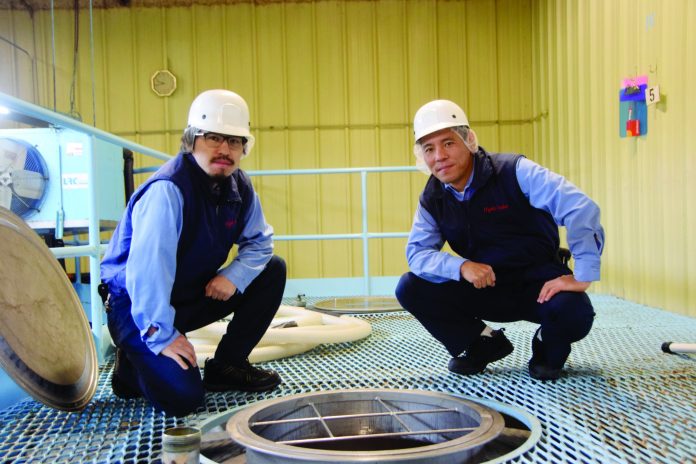
San Benito County has a long and proud history of excellent wineries, including Leal Vineyards and Winery, and Centani Vineyard in Hollister and the Aimee June Winery in San Juan Bautista—or if you’re in the mood for a beer and a shot, there’s Johnny’s Bar and Grill. But for those who crave a tasty pairing with their sushi, Ozeki Sake USA on Hillcrest Road has been producing high-quality sake locally since 1979.
In May 1979, amid a booming Japanese economy and the growing international popularity of Japanese cuisine and culture, Ozeki Corporation in Nishinomiya City, Hyogo Prefecture, Japan sought a site in the United States to expand its reach into the American market. In Hollister, they found two key components: good, clean water and a willing local partner with adequate production means in San Benito Winery.
“The water was great here; they called it Sierra Nevada water,” said procurement assistant manager Seiichi Matsuda.
Fast forward to today, and Ozeki Sake USA Inc. produces 4 million liters of sake every year, with annual sales of approximately $12 million. Ozeki Sake USA makes six different drinking sake and one brand of seasoning sake, none of which would be possible without using 12 million gallons of water a year from the San Benito County Water District, which costs the company approximately $20,000 every month.
Overall, Ozeki Corporation has between 350 and 400 employees who generated $140 million this year. Ozeki Sake USA has 35 to 40 employees, most of whom work in production at the 249 Hillcrest Road in Hollister.
Their sales would also not be possible with the skills of production manager Manabu Kotake and director of production Yoji Ogawa, both on six-year rotations in Hollister from their homes in Japan. The extended deployments can cause lengthy separations from family in Japan. While Kotake’s wife has joined him in Hollister, Ogawa left a family with two teenage children back in Japan.
Ozeki Sake USA. is one of five major sake producers in the United States, with three other facilities in California and one in Oregon. What makes Ozeki Sake unique to the other producers is their in-house rice polisher that can refine 8,000 pounds of rice a day.
The production process at Ozeki Sake USA starts with polishing rice grown in Northern California. Raw rice goes through a polishing machine; the fine powder left behind is sold to local farmers, who feed the residue to livestock.
After the rice is washed and soaked, it’s steamed and cooled, with 80 percent sent to the fermentation tanks and 20 percent turned into Koji rice, a crucial component in the sake producing process. Koji rice goes through a two-day organic process to produce a mold that ferments the rice by decomposing its carbohydrates and protein. At the end of the transformation, Koji rice obtains a sweetness that helps to add flavor to the sake.
All the rice is fermented in tanks at 50 to 70 degrees Fahrenheit for 20 days. The sake is then pressed, separating the solid remnants from the fresh sake, which is pasteurized and sent to storage tanks for up to six months. The final product goes through a filtration process and is bottled or bagged, inspected and packed for shipping on site.
The products include Ozeki Junmai Premium sake, a dry, full-bodied sake with a 16 percent alcohol content that can be served either chilled or hot, and Ozeki Junmai Daiginjo, a dry, light-bodied sake with a fruity aroma, 16 percent alcohol content and best served chilled.
Ozeki Sake USA ships to all of the United States as well as Canada, Korea, Argentina, Mexico, Peru, Brazil, the United Kingdom, France and Germany. Visit www.ozekisake.com/.









